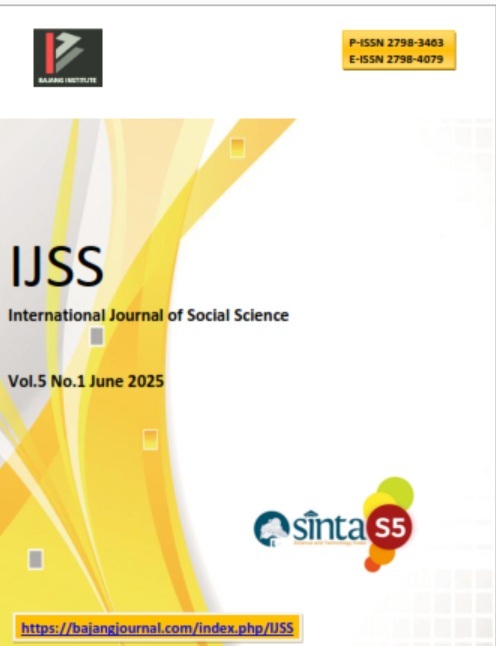AN ENVIRONMENTAL ACCOUNTING APPROACH IN ANALYZING THE IMPACT OF THE ECOTOURISM INDUSTRY, INNOVATION, INFRASTRUCTURE INVESTMENT, AND GREEN ECONOMY ON SUSTAINABLE CITIES AND COMMUNITIES IN THE MANDALIKA SPECIAL ECONOMIC ZONE, WEST NUSA TENGGARA
DOI:
https://doi.org/10.53625/ijss.v5i1.10490Keywords:
environmental accounting, ecotourism, innovation, green economy, infrastructure investment, sustainable cities and communities, Mandalika SEZ.Abstract
The development of sustainable cities and communities is an integral part of the Sustainable Development Goals (SDGs), particularly SDG 11. The Mandalika Special Economic Zone (SEZ) in West Nusa Tenggara has been designated as a national strategic project that requires environmentally oriented and participatory development governance. This study aims to analyze the influence of the ecotourism industry, innovation and creativity, infrastructure investment, and green economic practices on the development of sustainable cities and communities, using the environmental accounting approach as the conceptual framework.
A quantitative approach is employed using Structural Equation Modeling-Partial Least Squares (SEM-PLS). Data were collected through a survey of 210 respondents consisting of tourism actors, zone authorities, local communities, and investors. The results reveal that all independent variables—ecotourism industry, innovation, infrastructure investment, and green economy—have a positive and significant impact on sustainable cities and communities. Among these, green economic practices made the most dominant contribution. Furthermore, environmental accounting is proven to have a mediating role in strengthening the impact of these variables on regional sustainability.
These findings highlight that environmental accounting functions not only as a reporting tool but also as a strategic instrument for enhancing transparency, accountability, and performance evaluation of sustainable development in the Mandalika SEZ. This study contributes theoretically to the development of environmental accounting studies and provides practical implications for managing national strategic zones through a sustainability lens.
References
Bappenas. (2023). Laporan monitoring keberlanjutan wilayah strategis nasional. Ministry of National Development Planning/National Development Planning Agency (Bappenas).
Burritt, R. L., & Schaltegger, S. (2010). Sustainability accounting and reporting: Fad or trend? Accounting, Auditing & Accountability Journal, 23(7), 829–846. https://doi.org/10.1108/09513571011080144
Gössling, S., & Hall, C. M. (2019). Sustainable tourism: A global perspective. Routledge.
Hair, J. F., Hult, G. T. M., Ringle, C. M., & Sarstedt, M. (2020). A primer on partial least squares structural equation modeling (PLS-SEM) (3rd ed.). SAGE Publications.
OECD. (2018). Oslo manual 2018: Guidelines for collecting, reporting and using data on innovation (4th ed.). OECD Publishing. https://doi.org/10.1787/9789264304604-en
Prayitno, G., Wibowo, R., & Aini, M. S. (2021). Ecotourism and sustainability challenges in Mandalika SEZ. Jurnal Perencanaan Wilayah, 12(2), 135–150. (Original title: "Ekowisata dan Tantangan Keberlanjutan di KEK Mandalika")
Schaltegger, S., & Burritt, R. (2018). Business cases and corporate engagement with sustainability: Differentiating ethical motivations. Journal of Business Ethics, 147(2), 241–259. https://doi.org/10.1007/s10551-015-2938-0
UN-Habitat. (2020). World cities report: The value of sustainable urbanization. United Nations Human Settlements Programme.
UNEP. (2011). Towards a green economy: Pathways to sustainable development and poverty eradication. United Nations Environment Programme. https://www.unep.org/greeneconomy
United Nations. (2015). Transforming our world: The 2030 agenda for sustainable development. United Nations.
World Bank. (2020). Investing in sustainable infrastructure: The role of public-private partnerships. World Bank Publications.
Zeng, S., Meng, X., Zeng, R., & Tam, C. M. (2010). Green investment decisions for sustainable development: Empirical evidence from China. Journal of Environmental Management, 91(4), 1021–1030. https://doi.org/10.1016/j.jenvman.2009.12.003
Downloads
Published
How to Cite
Issue
Section
License
Copyright (c) 2025 darmansyah darmansyah, Mulia Rahmah, Arisetyanto nugroho

This work is licensed under a Creative Commons Attribution 4.0 International License.

















